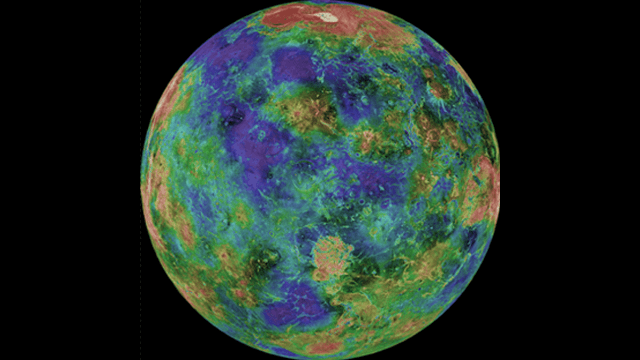Standing on the surface of Venus, your body would be crushed by the immense pressure, fried by the lead-melting heat, and dissolved by sulfuric acid thunderstorms. Too bad, because if you could survive on Venus, you might witness some epic volcanic eruptions.
A high resolution topo map of Venus’s surface produced by the Magellan spacecraft.
The longstanding hypothesis that Venus, like the Earth, is a volcanically active planet, is backed by new evidence published in Geophysical Research Letters. Combing through thermal imaging data from the Venus Express spacecraft’s Venus Monitoring camera, a team of geologists identified transient temperature spikes at several spots on the planet’s surface. The spikes, which upped the temperature several hundred degrees Celsius over a range of one to 200 square kilometres, are being interpreted as active lava flows.
“We were able to show strong evidence that Venus is volcanically, and thus internally, active today,” said study co-author James W. Head in a press release. “This is a major finding that helps us understand the evolution of planets like our own.”
The temperature anomalies in question were discovered in the Ganiki Chasma, a large rift zone that sounds like it could be the spawning grounds for a race of fire-loving kaiju. Mapped in the 80s and 90s by the Soviet Venera and US Magellan missions, the Chasma is a region (like our own East African rift) where crustal plates are stretching apart, causing hot mantle material to rise, decompress, and liquify.
“We knew that Ganiki Chasma was the result of volcanism that had occurred fairly recently in geological terms, but we didn’t know if it formed yesterday or was a billion years old,” Head said. “The active anomalies detected by Venus Express fall exactly where we had mapped these relatively young deposits and suggest ongoing activity.”
It’s the latest in a growing pile of data supporting volcanic activity on Earth’s nearest neighbour. In 2010, an infrared imagining analysis hinted at other lava flows that were anywhere from a couple thousand to a few million years old. Two years later, scientists reported transient plumes of sulphur dioxide — a product of volcanic eruptions — high above the clouds in the Venusian skies.
Volcanic activity seems to be a rarity in our solar system, occurring (to our knowledge) only on Earth and Io. Yet, perhaps it’s not surprising that Venus, a planet with an active climate system and a dazzling array of complex surface features, would also bear this hallmark of geologic activity.
Surprising or not, it’s certainly very cool.
